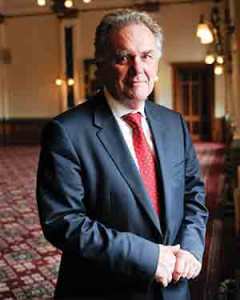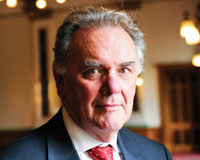 Cars, jewellery, Black Sabbath, Led Zeppelin – the Midlands is renowned for its metal exports in many forms. What is less well known is that the Midlands is the UK’s medical technology heartland, which means it produces quite a lot of hospital equipment and orthopaedic devices.
Cars, jewellery, Black Sabbath, Led Zeppelin – the Midlands is renowned for its metal exports in many forms. What is less well known is that the Midlands is the UK’s medical technology heartland, which means it produces quite a lot of hospital equipment and orthopaedic devices.
Together, the West and East Midlands are home to 30% of medtech companies, compared with 27% in the South East and East and 20% in the North. “The reason they don’t appear on the radar is that a lot of these are small companies, not the big pharmaceutical companies everyone knows about,” says Sir Albert Bore, leader of Birmingham city council.
Medtech is an £18bn subsector of the UK’s life sciences industry, accounting for half of life sciences jobs and two-thirds of companies, but generating just one-third of the total turnover. Bore has made it his mission to raise the profile of Birmingham and the wider Midlands region, not only for its existing strengths but as the destination of choice for the higher-value branches of the life sciences industry. He wants to put it firmly on the map for clinical research, not only among UK organisations but as a hub for scientists across the world.
To do this, the council and the Greater Birmingham and Solihull Local Enterprise Partnership are investing millions in new facilities to lure researchers to the city. Bore says it has identified an £800m portfolio of sites that could be brought forward for further development.
But there is a lot more to creating a genuine life sciences destination than simply building, and Bore is no doubt spending a considerable amount of time ensuring that companies will actually come. The UK’s life sciences sector is far from UK wide, and occupiers exhibit a very pronounced clustering effect. The greatest concentration of R&D is in the South East, and occupiers are extremely selective on location, even within hotspots, typically wanting to be in close proximity to other organisations in the same field of research.
Though he is Scottish by birth – and a physical scientist by profession, as a lecturer in nuclear reactor physics at Aston University – Sir Albert is easily up to the task of selling Birmingham to life sciences organisations. He has been a councillor for its Ladywood ward since 1980 and leader of the Labour group since 1999, and is involved in many of the city’s big-ticket regeneration schemes including the ICC, Birmingham Symphony Hall, Brindleyplace and the Bullring.
Birmingham may be a poor relation of the UK’s “golden triangle” for research between London, Cambridge and Oxford, but it has a lot to work with. In 2010, a massive PFI hospital opened next door to the University of Birmingham, which has one of the largest clinical trials programmes in the UK. This double-whammy has become the focal point for the city’s sales pitch to potential occupiers and investors.
“In a sense, what you’ve got is a cluster of excellence in terms of the Queen Elizabeth hospital complex, the University of Birmingham and, within that, the second-largest medical school in the country with more than 800 researchers. So we’re seeing at the heart of Birmingham this major hospital-university campus.”
Adjacent to that is Birmingham Research Park campus, on which a BioHub with facilities for start-ups has just opened. Later this year, a £24m Institute of Translational Medicine, part-funded by the LEP, will open its doors to 600 scientists conducting early-stage research. All this sits on the edge of what is known as the Edgbaston Medical Quarter, home to two-thirds of the city’s healthcare economy. Bore says: “You have a huge number of medical organisations, specialist care centres and training facilities. So what we have is a huge presence here and we’re going to add to it.”
That addition is the Life Sciences Campus, also adjacent to the university-hospital site. The city council is remediating the long-derelict Battery Park site in Selly Oak in association with the Harvest Partnership, a joint venture between Land Securities and Sainsbury’s. Two-thirds of the 30-acre site will be redeveloped as retail, leisure and student accommodation; the remainder will be the Life Sciences Campus, which is to be “a centre of excellence in medical research”.
 A retail-led project had been planned for the site when Labour retook the council in 2012 under Bore’s leadership. When the council asked Harvest to add in the 439,000 sq ft Life Sciences Campus, plans stalled, with the developers complaining that the downscaled retail element was not sufficient to fund the improvements promised. The application was approved in October 2013 after Harvest agreed to contribute more to the restoration of the canal on the site. Decontamination is now under way, expected to be complete by the start of 2016.
A retail-led project had been planned for the site when Labour retook the council in 2012 under Bore’s leadership. When the council asked Harvest to add in the 439,000 sq ft Life Sciences Campus, plans stalled, with the developers complaining that the downscaled retail element was not sufficient to fund the improvements promised. The application was approved in October 2013 after Harvest agreed to contribute more to the restoration of the canal on the site. Decontamination is now under way, expected to be complete by the start of 2016.
How does he plan to convince occupiers to shun the golden triangle and come to the Midlands instead? “We are absolutely convinced that because of what we have to offer and because of the opportunity that is here we will not have problems expanding this sector. The Institute of Translational Medicine is not even open yet and it is in effect full. The research that was done by Marketing Birmingham some years back showed that there was a significant proportion of foreign direct investment that comes into medical technology and life sciences, so we are not finding it difficult to be attractive, even on FDI.”
Birmingham’s killer USP, he believes, is its population – its size and its diversity. It is this that will enable it to broaden its life sciences activity into clinical research and clinical trials. Bore says: “Essentially, within an hour or so, we’ve got a population of 7m and we have the ethnic diversity that is absolutely important when you’re trying to do clinical trials. Cambridge has got the research activity but it can’t take it outside because it doesn’t have the population or the diversity of population. That’s not to undermine the importance of the Cambridge area, but we offer something that it is unable to.”
Aside from academia and clinical facilities, the third ingredient of a successful life sciences hub is a major private sector occupier. And if you really want to be a player on the world stage, a US firm.
How will he attract a firm like that? “The Life Sciences Campus will give us an early opportunity to do that. There’s something I can’t talk about here – watch this space.” When will he be able to say more? “When the conversations have gone a lot further than they have at the moment.”
The council will go out to the market later this year to appoint a development partner for the campus, and Bore expects to be able to reveal more as part of that process.
But he has no qualms about filling the space. “We are not looking at a spec proposition here,” he says. “I think we’ll find that occupation moves fairly swiftly toward that 100% figure. It won’t happen immediately but it will happen over a very short time, in my view.”
As for what he is looking for the partner to provide, he is open to suggestions. A number of options have been reviewed but the final decision has yet to be made. “We haven’t come down to one particular model because the University of Birmingham and University Hospital Birmingham are also involved and may be part of a partnership that helps to take this forward,” he says. So there’s everything to play for? “We will be a little flexible, but what we’ll be looking for is someone that we can take this forward with quickly and deliver the product that we’re looking for.”
While the ITM provides small-scale spaces for younger firms, the Life Sciences Campus will offer bigger units for home-grown and incoming firms to expand.
What about expanding the Birmingham cluster? There are not any available sites in the vicinity of the Battery Park site, for example, and occupiers will be reluctant to locate their R&D staff too far away.
There is no land immediately adjacent, says Bore, but there opportunities within a short distance. He gives St Modwen’s £1bn redevelopment of the Longbridge site four miles south as one example.
“There’s a portfolio of sites that we think we could provide within around 15 minutes of the Life Sciences Campus that could offer a range of accommodation for manufacturing, distribution and delivery,” he says. “The investment potential we have identified is around£800m.”
Birmingham was a very different place in 1980 when Bore was first elected in Ladywood. What has he learned from his involvement in its major transformation schemes this far?
“Believe in what it is you’re trying to provide,” he says, without missing a beat. “I think we’ve got it right, I think we’ve got the timing right, I think the Life Sciences Campus is the right product, and I think that the whole spectrum of medical technology and devices through to clinical trials work means we will be a much more recognised centre for life sciences in the years to come.”











